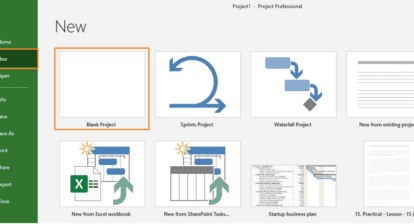
How you start a project is just as important as how you execute the project, if not more. In this article, we will explore the importance of project initiation, cover best practices, and share 6 key steps for how project managers can get their projects started on the right foot.
As the ancient Greek philosopher Plato once said, “The beginning is the most important part of the work.” When building a new home, digging the foundation is the first and most crucial step. Without a solid foundation, it doesn’t matter how beautiful the house is — it is only a matter of time before the house built on a faulty foundation becomes cracked and damaged, and begins sinking into the ground.
Seasoned project managers embarking on a new project know the importance of Plato’s wisdom. Project initiation represents a fresh start, and it’s an exciting time when you can use your experiences and vision to create a successful project. This phase sets the tone and foundation for the entire project. The success of any project depends on what you do during this pivotal stage — the foundation you lay impacts your project’s outcome.
What is Project Initiation?
Project initiation is the first phase of the project management life cycle. The Project Management Institute (PMI) defines project initiation as “the process of formally recognizing that a new project exists or that an existing project should continue into its next phase.”
Project initiation involves carefully evaluating the feasibility and viability of a project; it’s also when the project’s scope is developed. A project charter defines the project’s purpose and scope, establishes the project’s sponsor and key stakeholders, and identifies the high-level risks and assumptions of the project. As a project manager, this is your opportunity to assemble your project team, define your project’s objectives and goals, and develop a solid case to support your project.
Why Project Initiation is Important
While you may be ready to jump into a new project head-first, it is best to create a solid foundation first if you want to see your project succeed. Investing your time and energy in the project initiation process sets the project’s direction, establishes a clear vision, and provides context for the entire project’s life cycle.
Project initiation impacts the project’s outcome: projects that lack clear goals and objectives risk uncertainty, confusion, and the dreaded scope creep, leading to project delays, insufficient resources, and increased costs. Statistics show that a staggering 70% of all projects fail. On the bright side, failure rates are lower than 20% when proven project management practices (like project initiation) are implemented.
A solid project initiation phase also allows project managers and teams to assess whether the project aligns with the organization’s strategic objectives, prioritize, and align the project with the intended business impact
 project initiation process sets the project’s direction, establishes a clear vision, and provides context for the entire project’s life cycle.” class=”wp-image-542341″/>
project initiation process sets the project’s direction, establishes a clear vision, and provides context for the entire project’s life cycle.” class=”wp-image-542341″/>6 Key Steps for a Successful Project Initiation
Once you have an idea for a new project with potential, what’s next? These six key steps can help you successfully approach the project initiation phase and build a solid foundation for your project.
Draft a Business Case
A business case is a document that outlines the potential benefits of a project and how it aligns with an organization’s mission. You’ll want to answer the questions about how the project will increase profits, reduce risk, or meet the organization’s goals. Here’s where you can use your creativity and research skills to sell your project idea.
Think of your business case as a roadmap for your project, providing clear directions of the project objectives and how the project can help the organization reach its goals. A business case also serves as a tool for decision-making, helping project sponsors and stakeholders evaluate whether the project is worth pursuing.
Your business case should include the following:
- Analysis of the problem and proposed solution
- A comprehensive financial analysis, including costs and return on investment (ROI) you anticipate
- Analysis of potential risks and a risk management plan
- Defining key stakeholders
- Estimated timeline for the project
- Action plan for the project, including how decisions will be made and immediate next steps if the project is approved
This document serves as a tool for decision-making, helping project sponsors and stakeholders evaluate whether the project is worth pursuing. While the business case is a general overview, it should include as many details as possible. Focus on business aspects rather than getting into the nitty-gritty technical details.
Conduct A Feasibility Study
Once you’ve pitched your project, it’s time to assess the potential risks you may encounter throughout the project’s life cycle. A feasibility study can determine whether the project aligns with the organization’s strategic objectives and is worth pursuing. Carrying out due diligence this early on can help you avoid expensive setbacks or problems in the project’s later phases.
A feasibility study should identify and evaluate the project’s technical, financial, and operational aspects. As you conduct the study, consider the following:
- Whether the project is doable based on the technology, resources, and expertise available
- Is now the right time to initiate the project (and if not, when?)
- Potential costs and benefits, including the expected return on investment (ROI)
- Can the project be successfully implemented and integrated into existing systems and processes?
A solid feasibility study should use data to provide a transparent and objective evaluation of the project’s potential impact on the organization and stakeholders. This information is critical for decision-making, as it allows project sponsors and stakeholders to decide whether to proceed with the project, modify it, or abandon it altogether.
Develop a Project Charter
A project charter is a high-level document formally outlining the project team members’ scope, objectives, requirements, and roles. It should provide a clear understanding of the project, why it is being undertaken, and the expected outcomes. Developing a clear and concise project charter increases the likelihood of achieving your Project Goals.
A project charter should include the following:
- Project name and purpose
- High-level budget and resources requirements
- High-level risk assessment
- Essential project milestones and timeline
- Identify stakeholders
- Team member roles and responsibilities
- Expected results (success criteria)
A project charter serves as a reference point throughout the project, providing a baseline you and your team can refer to measure progress and sponsors and stakeholders can use to monitor the project.
 project initiation phase allows project managers and teams to assess whether the project aligns with the organization’s strategic objectives, and prioritize, and align the project with the intended business impact.” class=”wp-image-542342″/>
project initiation phase allows project managers and teams to assess whether the project aligns with the organization’s strategic objectives, and prioritize, and align the project with the intended business impact.” class=”wp-image-542342″/>Define the Scope
The project scope is a documented list of your project’s goals, tasks, costs, deliverables and deadlines. In addition, the project scope document defines the project’s boundaries, establishes responsibilities for team members, and outlines the procedures for how deliverables will be verified and approved. Along with defining the project, this document should clearly state what the project is not, to help avoid the dreaded scope creep.
A project scope statement should include the following:
- Goals and objectives
- Tasks, deliverables, milestones and deadlines
- Requirements
- Risks
- Costs
- Assumptions (e.g., assuming all team members will remain on the team throughout the life of the project)
- Boundaries (e.g., what is out of scope/what won’t you deliver?)
Defining the scope has some overlap with the project charter — the content and audience of both documents are essentially the same. Some project managers prefer to combine the two into one document, which you can most likely do if your project is internal. However, external projects may require both the project charter and scope. Whether you combine them or not, covering details necessary to the project, stakeholders, and your team is key.
Identify Stakeholders
As you identify project stakeholders, consider anyone involved, interested in, and affected by the project. This may include the client, project sponsors, consultants, team members, and the steering committee. Building a strong relationship with stakeholders is essential, and communication is the best way to do this. Frequent, open communication with stakeholders is vital to earning their support and ensuring the project is executed well and successfully.
Establish a Project Team
Once your project is approved, you can establish your project team. This involves identifying and assigning the roles and responsibilities of each team member. Doing this early in the project helps create a sense of responsibility and accountability from the start of the project.
Some things to keep in mind as you establish your project team:
- Recruit the right team: Team members can make or break a project, so take time to find the right people with the right skill sets. This can take some time, especially if you need to hire contractors or new employees.
- Team structure: How will the hierarchical structure of your team work? Is the project small enough that everyone reports to you as the project manager, or will there be team leads for each area of expertise (e.g., IT)?
- Infrastructure: If your team works onsite, consider the office space or meeting rooms you need before your project kick-off. If your team works remotely, ensure you have the tools to manage a virtual team effectively. MS Teams, for example, allows for real-time communication and collaboration, document and app sharing, and messaging.
Review
Even the most experienced project managers can overlook things and make mistakes, so review your project initiation work before you move on to project planning. Reviewing your initiation documents is the best way to ensure you have caught everything and set the rest of your project up for success.
Conclusion
A successful project initiation phase lays a strong foundation on which you can build the rest of your project. Though it can be a time-intensive process, executing a thoughtful and thorough project initiation phase is one of the best things you can do to ensure your project is executed smoothly and meets your client’s and stakeholders’ expectations.
Related Articles
How to Make the Most Out of A Project Initiation Meeting







